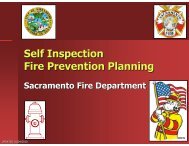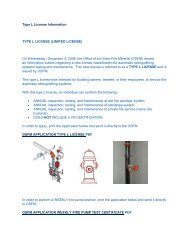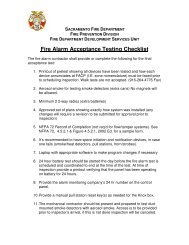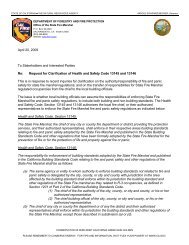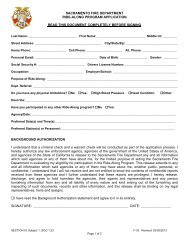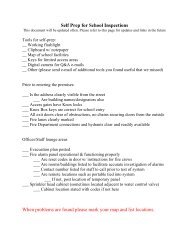EMERGENCY MEDICAL SERVICESThe <strong>Sacramento</strong> Fire Department has provided paramedic transport services in the City of <strong>Sacramento</strong> since 1994. The EmergencyMedical Services (EMS) Division’s goal is to provide the highest level public service to the customer. EMS, in concert with other <strong>fire</strong><strong>department</strong>s’EMS divisions, participates in shaping pre-hospital care through collaboration with the <strong>Sacramento</strong> County EMS authority,local hospitals and community organizations. These partnerships have resulted in the development and implementation of highquality patient care, improved recognition and <strong>report</strong>ing of infant, child and elder abuse; sexual assaults; and domestic violence. Ongoingeducational programs, research projects, and publications are also a result of these affiliations. EMS continues to provide opportunitiesto paramedic students for preceptorships and sponsors a paramedic student intern program; however, the intern program hasbeen temporarily suspended until further notice.The Advance Life Support (ALS) and Transportation program has twelve 24-hour ambulances placed in service to ensure timely arrivalof advanced care providers to those in need. As the patient call volume is continually evaluated the <strong>department</strong> is able to also deployup to two additional flex ambulances during peak hours throughout the City and contracted areas. All engines and trucks areBasic Life Support (BLS) capable with approximately 95% of the units providing paramedic services on a daily basis.To improve the performance and quality of our patient care, the EMS Division established a Peer Review Committee and ContinuousQuality Improvement (CQI) program. Comprised of Firefighter/Emergency Medical Technician (FF/EMT-1) and FF/EMT-P, theEMS Peer Review Committee provides a perspective on patient care issues raised by medical authorities. The committee examinesnew medical equipment, evaluates existing medical equipment and makes recommendations to the EMS Division. In <strong>2009</strong>, the committeeexamined and made recommendations regarding protocol compliance, Continuous Positive Airway Pressure (CPAP), and auditcriteria. The CPAP was deployed in January <strong>2009</strong> and resulted in improved outcomes for the critical patients. The positive feedbackon the efficacy of this device prompted the peer review committee to recommend the continued use by the Department.The CQI program educates and trains personnel to the highest standards in quality patient care. This program received high marks inthe past from the <strong>Sacramento</strong> County EMS Agency (SCEMS). Patient Care Reports (PCRs) are reviewed for completeness, appropriatenessand protocol compliance. The CQI program reviews and analyzes any concern or issue by patient, family member, or medicalauthority through its established channels. Concerns brought forth in this process are assessed for protocol compliance, and are evaluatedto ensure that treatments rendered meet the standard of care.Probationary FF/EMT-P and FF/EMT-I employees continue to undergo the established CQI process of their four, eight, and twelvemonth to evaluate their EMS knowledge and skills. The sessions included assessment of their knowledge regarding County policiesand procedures, rapid patient assessment and interventions, interpretation of cardiac rhythms, and manipulation of required skills,such as intubation. As many of the probationary FF/EMT-P have limited experience as paramedics, the assessments were very beneficialin identifying specific needs for the individual medic.In <strong>2009</strong>, three Multi-Company Training (MCT) drills were conducted. The major focus of the drills was on the anticipated pandemicthreat and community’s response. The goal was toeducate, heighten awareness, and develop a pandemicHospital Destinations <strong>2009</strong> response plan for the H1N1 virus. Each drill providedan opportunity to update our personnel regarding thestatus of our H1N1 response. In addition the annualmandatory training and review of patient care documentation,the drills included the first seasonal influenzavaccination ever done by the Department.Continued infection control training done by the DepartmentDesignated Infection Control Officer hasbeen beneficial in reducing the incidence of MethicillinResistant Staphylococcus Aureus (MRSA) which wasidentified as a problem for SFD personnel in 2008.SFD personnel have been responsive to using waterlesshand hygiene products, and cleaning wipe-cloths thatwere introduced to inhibit the spread of the bacteria.<strong>Sacramento</strong> Fire Department <strong>2009</strong> <strong>Annual</strong> Report ~ Page 12
EMERGENCY MEDICAL SERVICESTop Provider ImpressionsIn <strong>2009</strong> policy drafts were written for pandemicresponse. These policies were adopted by theCalifornia Department of Public Health, FolsomFire Department, and other agencies whoadapted portions of them to their responseplans. The plan included: infection controlmeasures adapted from Center for Disease Controlguidelines; modified staffing guidelines forincreases in call volume, and decreases in personneldue to illness; inventory control measuresfor supplies, medications, and personalprotective equipment; education of staff and thecommunity; transportation modalities based onpatient call volume; and inter-agency communicationto relay situation/status updates.The <strong>department</strong> continues to foster an educationalpartnership with the University of Californiaat Davis Medical Center (UCDMC).Fourth year medical students ride along withthe Medic Units to gain a better understanding of the <strong>fire</strong> service, field treatment, and SCEMS policies and procedures. Mobile IntensiveCare Nurses (MICN) who receive radio <strong>report</strong>s from paramedics on patient status are mandated to ride along in a medic unit.This program provides nurses the opportunity to observe FF/EMT-P interacting with patients in the pre-hospital setting. Manynurses from local hospitals have taken advantage of this program. As part of their EMS rotation, the Emergency Residents from theUCDMC also ride along and present medical lectures to the SFD FF/EMT-P to provide them with advanced assessment skills andtools. The UCDMC Emergency Residents are also committed to provide medical lecture on topics which include Hypothermia, Bitesand Envenomation, Pediatric Orthopedic Emergencies, Obstetrical Emergencies, and Anaphylaxis. This joint venture has proven to bea great partnership.The EMS Division provided paramedic field training to numerous outside agencies including ARC, METS, and NCTI. While the minimumfield training hours are 480, most of our paramedic preceptors provided 600 to 720 hours of field training to the outside agencyparamedic student. Without this important field training, a paramedic student would not be able to complete the requirements tobecome a paramedic.EMS partners with the <strong>Sacramento</strong> Adult Education, specifically Old Marshall School, in providing EMT-1 and EMT-P training to thecommunity. The goal of the program is to tap into the diversity that <strong>Sacramento</strong> has to offer. Old Marshall employs SFD personnel asinstructors, and SFD provides the equipment and suppliesneeded for the EMT and EMT-P classes. It is aRun Dispositionmutually beneficial program; however, due to fiscalconstraints this partnership was ended.The EMS Division is an active member and participantin community programs. The EMS Division is a memberof the Elderly Death Review Team and the ChildDeath Review Team. Case information is compiledfrom SFD Records Management System and presentedat team meetings. EMS has also been involved withMercy General Hospital’s process for Accreditation asa Cardiac Center by participating in their door-toballoonprogram meetings. Door-to-balloon programsare geared toward transporting cardiac patients to definitiveCardiac Care Facilities which provide access torapid cardiac interventions.<strong>Sacramento</strong> Fire Department <strong>2009</strong> <strong>Annual</strong> Report ~ Page 13




